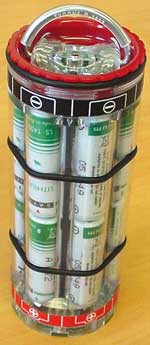November 2011
FIELD SERVICE BULLETIN NO. 23
![]() SBE 37 Pumped MicroCATs with
Batteries (SMP, IMP) and SBE 44 Underwater Inductive Modems
SBE 37 Pumped MicroCATs with
Batteries (SMP, IMP) and SBE 44 Underwater Inductive Modems
November 2011
![]()
![]() Print version
Link to all Field Service Bulletins
Print version
Link to all Field Service Bulletins
 This
field service bulletin applies to the following instruments using the red-top
retrofit battery pack:
This
field service bulletin applies to the following instruments using the red-top
retrofit battery pack:
Note: The Field Service Bulletin does not apply to:
Problem 1 – Battery Fails Prematurely
The red-top retrofit battery pack was introduced in 2008, replacing the original batteries (six custom-built 9-volt batteries made from 3 Panasonic BR-2/3A lithium cells each) with 12 AA lithium cells in a battery pack. After July 2008:
One of the expected advantages of the red-top retrofit battery pack was a large increase in the usable capacity. As stated in earlier versions of Application Note 89 (Retrofit Battery Pack for SBE 37 MicroCAT and SBE 44 Underwater Inductive Modem), the red-top retrofit battery pack was expected to deliver approximately 75% more usable capacity than the old custom-built 9-volt battery, allowing for significantly longer deployments and/or more frequent sampling.
However, we have had several reports from customers using the red-top battery pack in pumped MicroCATs that the battery endurance was significantly below the value estimated by the Sea-Bird Deployment Endurance Calculator software (or hand calculations based on examples provided in the instrument manual). Additional investigation and thorough testing at Sea-Bird has confirmed that the original estimates are not sufficiently conservative as a result of the combination of the power consumption patterns of the pumped MicroCATs, the power discharge curves of the AA lithium batteries, and the design of the red-top battery pack. It is anticipated that SBE 44s providing power to the RS-232 sensor may have similar power consumption patterns as the pumped MicroCATs, with large current draws.
Problem 2 – Status Command Shows No Samples
in Memory
(applies only to 37-SMP with firmware < 3.0, or 37-IMP with digital firmware <
3.0)
In some cases of premature battery failure, the status command (DS or #iiDS, as applicable) response shows that no samples have been taken (samplenumber = 0). This indication results from the rapid shutdown of the MicroCAT before it can save the most recent sample number, and is not valid. Despite the indication in the status response, the MicroCAT did sample and does have recoverable data in its memory, although the sampling ended prematurely. Do not log any additional data until you have uploaded the data in memory, or you will overwrite the existing data.
Problem 1– Battery Fails Prematurely
Sea-Bird updated the Deployment Endurance Calculator for the specified pumped MicroCATs to reflect the above information, de-rating the battery capacity to 65% of the previously recommended value (0.65 * 8.8 Amp-hours == 5.7 Amp-hours). Note that this capacity is still higher than that provided by the old custom-built 9-volt battery (5 Amp-hours). All customers should install the latest version of Deployment Endurance Calculator (version 1.3 or later) for use with the affected MicroCATs.
If performing hand calculations, use the de-rated battery capacity of 5.7 Amp-hours in your calculations.
Problem 2 – Status Command Shows No Samples
in Memory
(applies only to 37-SMP with firmware < 3.0, or 37-IMP with digital firmware <
3.0)
Notes:
- Do not log any additional data until you have uploaded the data in memory, or you will overwrite the existing data.
- If using a MicroCAT with RS-485 communications or with Inductive Modem (IM) communications, preface all commands with #ii, where ii=MicroCAT ID (0-99). For example, #01Format=0 sends the Format=0 command to the MicroCAT with ID=01.
Send Format=0 to set the data format to raw data.
Send DS to display the status. Note the information showing the amount of memory used and the amount of memory available (samplenumber=0, free=X). For this case, with apparently no data in memory, X is the total memory size.
Send SampleNum=(X-100) (for example, if samplenumber=0, free=190546, send SampleNum=190446).
Click the Capture button in Seaterm to capture everything on the screen to a .cap file. In the Open dialog box, enter the desired file name and click Open.
Upload data with the DDb,e command (for the example, DD0,190446); the terminal program will capture the data to the .cap file designated in Step 4.
Click the Capture button in Seaterm again to turn off the capture.
Open the .cap file using software that can handle a large file rapidly, such as TextEdit (NotePad is not recommended):
Enable line number display in the software. Each line is one scan of data.
Search from the top for ffffffff. All lines below there are all ffffffff, you are looking at the unwritten area of the memory. Record the line number of the line preceding the first ffffffff and subtract 32, which is the length of the header (for example, if ffffffff appears on line 100,000, calculate 100,000 – 1 – 32 = 99967).
Upload the data from 0 to the number calculated in Step 7 (for example, from 0 to 99967). See the MicroCAT manual for upload details – if you use Seaterm’s Upload button, you can then use its Convert button to create a file that can be further processed/plotted in SBE Data Processing.
Contact Sea-Bird if you need assistance.
![]()
Sea-Bird Home Phone: (+1) 425-643-9866 E-mail: seabird@seabird.com